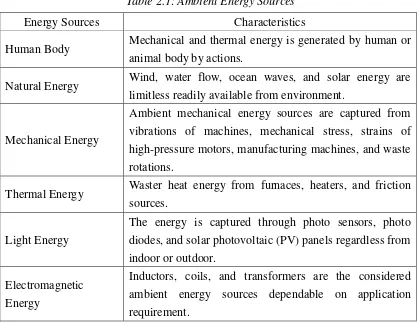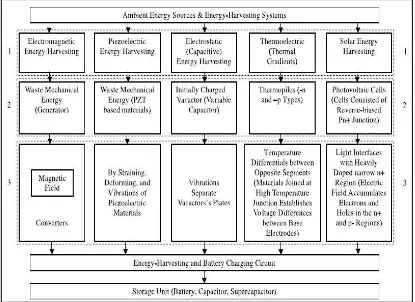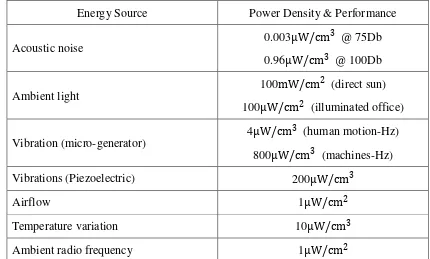i
DESIGN OF MICRO-POWER GENERATOR BASED ON
ELECTROMAGNETIC MECHANISM HARVESTING ENERGY FROM DIRECT AIR FLOW
TAN JYE GIN
A thesis submitted
in fulfillment of the requirements for the Bachelor Degree Of Electronic Engineering (Industrial Electronic)
Faculty of Electronic Engineering and Computer Engineering
UNIVERSITI TEKNIKAL MALAYSIA MELAKA
iii
“I declare that this thesis entitle “DESIGN OF MICRO-POWER GENERATOR
BASED ON ELECTROMAGNETIC MECHANISM HARVESTING ENERGY FROM DIRECT AIR FLOW” is the result of my own reaesrch except as cited in the
references. The thesis has not been accepted for any degree and is not concurrently submitted in candidature of any other degree.”
Signature : ...
Name : TAN JYE GIN
iv
“I declare that I have read this work and in my opinion this work is adequate in terms of scope and quality foe the purpose of awarding a Bachelor’s Degree of Electronic
Engineering (Industrial Electronics).”
Signature : ...
Name : DR. KOK SWEE LEONG
v
To my beloved family and friends who, of all that walk the earch, are most precious
vi
ACKNOWLEGEMENT
In preparing this thesis, I was in contact with many people, researchers, academicians and practitioners. They have contributed towards my understanding and thought. In particular, I wish to express my sincere appreciation to my thesis supervisor, Dr. Kok Swee Leong, for encouragement, guidance critics and friendship. Without his continued support and interest, this thesis would not have been same as presented here.
I am also indebted to University Techinical Malaysia Malacca (UTeM) in allowing me to use entire facilities available to complete my testing and studies.
vii
ABSTRACT
viii
ABSTRAK
ix
2.1.3 Comparison of Power Density of Energy Harvesting Methods 11 2.1.4 VibrationEnergy-Harvesting Techiques 12 2.2 Basic Principles of Electromagnetic Energy-Harvesting 12
2.2.1 Working Principles 12
2.2.2 Faraday’s Law 14
2.2.3 Voltage Multipliers 14
2.3 Previous research related to current study 15
3. METHODOLOGY
3.1 Experimental Flow Chart 22
3.2 Simulation Software 24
3.2.1 Multisim Software 24
3.2.2 Proteus Software 25
3.3 Hardware Protype 26
4. RESULT AND DISCUSSIONS
4.1 Theoretical Hypothesis 30
x
4.2.1 Experimental Result 31
4.3 Stages of Multipliers 32
4.3.1 Simulation Result 33
4.3.2 Experimental Result 41
4.4 Discussion of Result 46
4.4.1 Stages of Multipliers 46
4.4.2 Comparision of Design 49
4.5 Fabrication Citcuit 51
5. CONCLUSION & SUGGESTION
5.1 Conclusion 53
5.2 Suggestion for Future Development 54
REFERENCES 56
xi
LIST OF TABLES
TABLE TITLE PAGE
2.1 Ambient Energy Sources 9
2.2 Comparison Power Density of Energy Harvesting Methods 11 2.3 Comparison of Vibration Energy-Harvesting Techniques 12 2.4 Comparison of electromagnetic vibration transducer prototypes 16
3.1 Common magnetic material properties 27
3.2 Specification of Energy Harvester 29
4.1 Result of Output Voltage 32
4.2 Simulation Output Voltage for Input Voltage = 0.1V 34 4.3 Result of Simulation Power for Input Voltage = 0.1V 37 4.4 Simulation Output Voltage for Input Voltage = 0.5V 39 4.5 Result of Simulation Power for Input Voltage = 0.5V 40 4.6 Experimental Output Voltage for Input Voltage=0.1V 42 4.7 Result of Experimental Power for Input Voltage = 0.1V 43 4.8 Experimental Output Voltage for Input Voltage=0.5V 44 4.9 Result of Experimental Power for Input Voltage = 0.5V 45
xii
LIST OF FIGURES
FIGURE TITLE PAGE
1.1 Power consumption of various wireless standards 2 1.2 Projected Annual Battery Change Labor Cost 4 2.1 Scavengable Energies from Non-Biological Converted To
Electrical Energy for Use by Small Electric Unmanned Systems
8
2.2 Ambient Energy Systems 10
2.3 Comparisons of Battery and Energy Harvesting 10
2.4 Karman vortex street 13
2.5
2.6 Cantilever-Based Electromagnetic Micro-Generator 17 2.7 Relative Displacement in Electromagnetic Micro-Generator 17
2.8 Energy Harvester from Airflow 18
2.9 Principles Of Energy Harvester 19
xiii
3.6 Acrylic 28
4.1 Graph of Mean Output Voltage vs Number of Turns of Coil 32
4.2 Designed Circuit 33
4.3 Simulation of Input and Output Waveform for Input Voltage = 0.1V
33
4.4 Result of Measuring Voltage for Input Voltage = 0.1V 34 4.5 Comparison of Theoretical Capacity and Energy Stored 35 4.6 Simulation Power Generated for Input Voltage = 0.1V 37 4.7 Simulation of Input and Output Waveform for Input
Voltage=0.5V
38
4.8 Result of Measuring Voltage for Input Voltage = 0.5V 38 4.9 Comparison of Theoretical Capacity and Energy Stored 39 4.10 Simulation Power Generated for Input Voltage = 0.5V 40
4.11 Experimental circuit 41
4.12 Comparison of Theoretical Capacity and Energy Stored 42 4.13 Experimental Power Generated for Input Voltage = 0.1V 43 4.14 Comparison of Theoretical Capacity and Energy Stored 44 4.15 Experimental Power Generated for Input Voltage = 0.5V 45
4.16 Comparison of Voltage Output 48
4.17 Experimental Results with Standard Deviation 48
4.18 LTC 3535 in DFN Package 49
4.19 Circuit Layout of LTC 3535 50
4.20 Performance of LTC 3535 50
4.21 Snapshots from Proteus 51
4.22 Snapshots from ARES 51
4.23 Successful Fabricated Circuit (Front) 52
1
CHAPTER 1
INTRODUCTION
In this chapter, the discussion is mainly about the introduction and motivation of this project. The investigation is included the background of project, project
overview, problem statement that inspired, objectives to carry out and the scope for the project. The overall report structure is concluded at the end of this chapter.
1.1 General Background
2
The argument of environmental damage from wind energy has been debated. The wind energy system impacts on noise pollution and visual pollution. The large-scale wind generation systems are built in more remote area and create noise pollution which harshly harmful to native animal species as well as the nearby residents. Visual pollution changes the image of the landscape. Climatological impacts from wind generation system are also come across discussion. In the early stage of implementation, avian mortality was an issue. The birds flying in close
proximity were likely to be dragged into the flow and killed [8].
Energy harvesting technologies are ideas of alternative energies by converting non-electric environmental ambient energy into electrical energy. Obtaining an energy autonomous and maintenance-free sensor system with long-availability life time is the priority achievement [9]. Figure 1.1 shows the power acquired by special purpose low-data rate network protocols such as Zigbee for transmission [6].
Figure 1.1: Power consumption of various wireless standards [6]
3
1.2 Project Overview
Ambient energy harvester is known as power scavenging method. In this context, airflow is presented naturally and regarded as an environment-friendly power source.
The airflow energy harvester is proposed to have a geometry made of a wing
that attached to a cantilever spring, permanent magnet, coil, ferromagnetic circuit with air gap and a conversation circuitry.
Alternating current (AC) is induced in a conductive coil when magnetic flux changes. This can be done by either moving the coil or the permanent magnet. In this project, air flow is used as the ambient source to oscillate a magnet which is attached to a cantilever. When the direct airflow is entering the energy harvester, it is blocked by the bluff body constructed. A vortex is circulated under the cantilever. Current is generated when the cantilever moving along with the magnetic and cut the magnetic flux through the moving coil. Power is harvested from this system is capable to
power up some small electronic devices such as wireless sensor node.
1.3 Problem Statement
4
Thus, energy storage technologies have been greatly developed in the recent past. However, the progress has not been mature to keep up with microprocessors, memory storage, and wireless technology applications. The battery life time is limited which unable to last for a longer period of time. Figure 1.2 illustrates the annual battery change labor cost[5]. Maintenance of a large-scale network is difficult to carry out for hundreds or thousands of sensor nodes [14].
Figure 1.2: Projected Annual Battery Change Labor Cost [5]
According to Zhu [16], the smart buildings in technology-driven generation are equipped with intelligent systems which acquired numerous sensors. Wired sensors have some drawbacks on high wiring and maintenance costs and time consuming. Hence, wireless self-powered sensors are desirable in applications of systems. However, batteries as a conventional power supply have a finite amount of energy, difficulties to deploy in large scale or inaccessible locations and required
5
1.4 Objectives
Three specific objectives have been defined for this study;
1. To design an energy harvester based on electromagnetic mechanism harvesting ambient energy from airflow.
2. To construct a prototype of the energy harvester using available
materials.
3. To analysis the workability of the air flow energy harvester on a daily application.
1.5 Scope of the Project
Scope is designed so that the project is within the area of concern. The scopes of the project are as follows:
1. The experiment is conducted in a fabricated tunnel which has length of 1-2metres and height of ≈25cm.
2. Size of energy harvester is small (12cm x 8cm x 6cm). 3. The airflow source is within closed environment.
4. The power harvested is in the range of mW and the voltage induced is lesser than 2V.
6
1.6 Report Structure
In this report, there are three chapters are written. Each chapter has dedicated different focus and discussions.
As in Chapter One, the project is introduced. Brief general background, inspired problem statement, objectives, limits of the report is outlined.
Literature review is the main concern in Chapter Two. The literature review evaluates the previous research that has been proposed. The review is described and summarized.
Chapter Three is reporting on the methodology. The purpose of this chapter is to explain and document the research approaches and testing strategy carried out in the project.
Chapter Four is discussing the results and observations obtained .throughout
the research. Analysis on the output is presented for theoretical, simulation and experimental findings.
7
CHAPTER 2
LITERATURE REVIEW
In this chapter, existing knowledge is outlined. The relevant information on previous technologies is identified and justified.
2.1 Introduction
8
2.1.1 Ambient Energy Sources
Several of scavenging energy sources is categorized into five majors which are photonic, kinetic, thermal, electromagnetic, autophagous (self-consuming) structure-power. A suggestion [10] of scavengable energies from non-biological is illustrated in Figure 2.1.
Figure 2.1: Scavengable Energies from Non-Biological Converted To Electrical
Energy for Use by Small Electric Unmanned Systems
9
Table 2.1: Ambient Energy Sources
Energy Sources Characteristics
Human Body Mechanical and thermal energy is generated by human or animal body by actions.
Natural Energy Wind, water flow, ocean waves, and solar energy are limitless readily available from environment.
Mechanical Energy
Ambient mechanical energy sources are captured from vibrations of machines, mechanical stress, strains of high-pressure motors, manufacturing machines, and waste rotations.
Thermal Energy Waster heat energy from furnaces, heaters, and friction sources.
Light Energy
The energy is captured through photo sensors, photo diodes, and solar photovoltaic (PV) panels regardless from indoor or outdoor.
Electromagnetic Energy
Inductors, coils, and transformers are the considered ambient energy sources dependable on application requirement.
2.1.2 Ambient Energy Systems
10
Figure 2.2: Ambient Energy Systems
Energy harvesting has different charging rate across time and physical domains. The energy harvesting has shorter duty cycle and the average charging rate is lower than the rate of energy consumption. Figure 2.3 shows the comparison of battery and energy harvesting.
11
2.1.3 Comparison of Power Density of Energy Harvesting Methods
Kazmierski [3] reported that power densities acquired from machine vibration application and human-powered application are 800μW/cm3 and 140μW/cm3 respectively. The power output for vibration-harvesting inertial generators is highly stimulated by frequency and amplitude of the vibration source.
In the study of Yildiz [14], the comparison of power density of energy harvesting methods is highlighted in Table 2.2. The values are summarized from published studies, experiments conducted and the information captured by reading materials. From the Table 2.2, a wide range of potential scavenging energy from various ambient energy sources is provided.
Table 2.2: Comparison Power Density of Energy Harvesting Methods
Energy Source Power Density & Performance
Acoustic noise
Vibrations (Piezoelectric) 200μW/cm3
Airflow 1μW/cm2
![Figure 1.1: Power consumption of various wireless standards [6]](https://thumb-ap.123doks.com/thumbv2/123dok/552116.64941/15.595.121.528.427.713/figure-power-consumption-various-wireless-standards.webp)
![Figure 1.2: Projected Annual Battery Change Labor Cost [5]](https://thumb-ap.123doks.com/thumbv2/123dok/552116.64941/17.595.114.527.240.493/figure-projected-annual-battery-change-labor-cost.webp)



